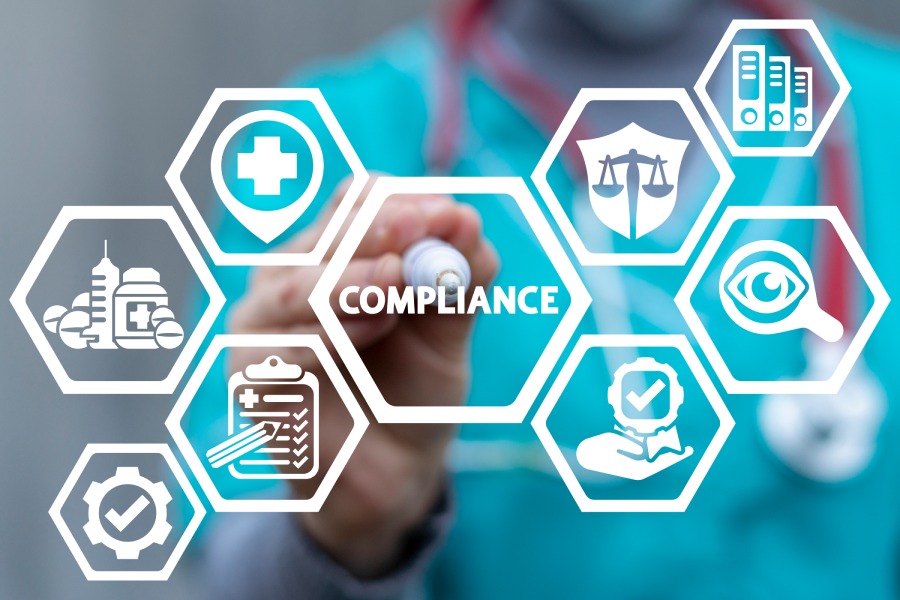Regulations and standards are crucial across all industries to ensure proper operations, safety, and quality. And healthcare is no exception. Healthcare providers must adhere to several strict guidelines and laws to safeguard patients and maintain trust. But what are these strict regulations, and what is compliance in healthcare?
Below, you’ll learn everything you need to know about compliance in healthcare and its significance!
Medical Billing Compliance
So, what is compliance in healthcare? Medical billing compliance refers to accurately and legally adhering to rules, regulations, and standards governing the billing and reimbursement processes in healthcare administration. It encompasses various areas, including proper medical code use, timely claim submission, patient privacy and confidentiality, and compliance with payer guidelines and contractual agreements.
By ensuring medical billing compliance, your organization guarantees transparency, accuracy, and integrity throughout the cycle, making medical billing compliance critical for proper documentation and ethical billing practices. The regulations surrounding medical billing compliance policy come mainly from:
- Health Insurance Portability and Accountability Act (HIPAA)
- Medicare Access and CHIP Reauthorization Act (MACRA)
- Affordable Care Act (ACA)
- Centers for Medicare & Medicaid Services (CMS) guidelines
- State laws
- Health insurance policies
However, many medical clinics struggle to thoroughly comply with medical billing regulations due to the complexity and frequent updates of the regulatory standards, limitations, and requirements.
Consequences of non-compliance
Failure to comply can lead to serious consequences and significant repercussions, including:
- Penalties, fines, and loss of licensure
- Revenue leakage
- Civil lawsuits
- Claim denials from Medicare, Medicaid, and third-party insurers
- Loss of community trust and brand reputation
Thus, CLICKVISION BPO strives to help all healthcare organizations achieve complete compliance with medical billing regulations by offering tailored and advanced services for each clinic. With a comprehensive understanding of common challenges, our team ensures seamless integration of regulatory requirements with optimized accuracy and streamlined billing efficiency.

Source: shutterstock.com/ Photo Contributor: Panchenko Vladimir
What Is a Compliance Program in Healthcare?
A compliance program is a structured set of policies, procedures, and processes designed to detect, prevent, and correct actions that do not align with the legal, ethical, and professional standards governing healthcare organizations. These programs are tailored to each organization’s needs and evolve, integrating training and audition to ensure practical implementation.
Its purpose is to foster an ethical environment that prioritizes adherence to legal and payer regulations, reducing the risk of fraud, waste, abuse, and other liabilities. As your organization adopts effective compliance programs, you promote patient safety, improve billing processes, and build trust and recognition among your community.
Moreover, an effective compliance program in healthcare should constitute at least seven core elements essential for the effective implementation of adherence to regulatory standards. It includes the following:
- Written policies, procedures, and standards of conduct
- Compliance officer, compliance committee, and high-level oversight
- Internal monitoring and auditing
- Consistent enforcement of standards and disciplinary guidelines
- Corrective action and prompt response to compliance issues
- Training and education
- Open lines of communication
These core elements collectively ensure that your healthcare organization maintains regulatory integrity and ethical conduct while mitigating risks associated with noncompliance in the industry. We’ll delve into each key element of compliance programs, giving you a deeper understanding of their significance and implementation.
1. Written policies, procedures, and standards of conduct
This element encompasses developing and maintaining detailed policies, procedures, and codes of conduct. They are easily accessible, regularly updated, and reflect your organization’s commitment to compliance.
It includes written policies and procedures. For example, descriptions of roles and responsibilities, employee training, operational processes, interaction with other organizational functions, and methods of measuring compliance program activities.
2. Compliance officer, compliance committee, and high-level oversight
Organizations must designate a compliance officer. It should establish a compliance committee within the clinic to observe and manage compliance efforts, ensure adherence, report directly to senior management, and address compliance issues.
3. Internal monitoring and auditing
Implementing a system to monitor and audit the compliance program is paramount. It measures the program’s effectiveness and ensures compliance with regulatory requirements and regulations.
4. Consistent enforcement of standards and disciplinary guidelines
Constantly reinforcing organizational standards through clear, well-publicized disciplinary guidelines is another core element of compliance programs. This ensures accountability and promotes a culture of adherence to regulations.
5. Corrective action and prompt response to compliance issues
Organizations should promptly address compliance issues through appropriate actions, such as repayment, disciplinary measures, education and training, and policy adjustments. This helps prevent future violations.
6. Training and education
This element emphasizes the need for providing comprehensive compliance training and education to all staff within an organization. It ensures awareness of standards, expectations, and reporting mechanisms to maintain adherence.
7. Open lines of communication
Establishing open lines of communication within your healthcare organization is essential to address compliance errors, education, and regulatory concerns. It ensures timely reports on issues and risks and allows you to mitigate them promptly.

Source: shutterstock.com/ Photo Contributor: Rawpixel.com
Challenges and Barriers to Compliance
Compliance is important for organizations as it ensures adherence to legal and regulatory requirements, mitigating penalties and legal consequences risks. While every organization within the healthcare industry must adhere to these set regulations, maintaining compliance may not be as easy as it might seem.
From challenges of keeping up with evolving standards and regulations to cultural barriers and resource constraints, manu clinics struggle to upkeep adherence. As many of these issues arise from the complex and shifting nature of compliance regulations, they often demand comprehensive approaches and adaptable strategies. With that said, here are some of the most common challenges and barriers to compliance:
Complying with standards in an evolving landscape
In an ever-evolving landscape, complying with changing standards and regulations is a constant struggle for healthcare organizations. This is because failure to prepare adequately can lead to substantial penalties and losses.
Keeping up with the governing bodies’ frequent updates and revisions can be challenging. Yet, establishing a robust system for staying informed about regulatory changes can mitigate any risk of noncompliance and ensure compliance and adherence.
Resource constraints
Many medical organizations face significant resource constraints in terms of staffing, advanced technology, and financial resources, making compliance challenging. However, prioritizing compliance efforts based on risk assessment, such as auditing or documentation, can help you adhere to regulations even with such limitations.
Cultural barriers
Cultural barriers pose another challenge for organizations striving to comply with regulatory standards by impacting the communication, acceptance, and adoption of compliance measures across diverse teams and stakeholders. By fostering a culture of compliance through education and inclusive engagement, you can ensure alignment with regulations in every aspect of your clinic.
Managing and security patient data
Managing the security of patient data presents the most significant challenge for healthcare organizations striving to comply with regulatory standards. Due to the complex nature of protected health information and electronic PHI, many clinics face significant barriers in implementing comprehensive security measures.
However, organizations can add layers of security efforts by navigating the dispersion of this data across multiple platforms and devices with stringent security mechanisms and guidelines. This way, they can ensure compliance with HIPAA data management regulations.
Compliance Training and Education
In the healthcare sector, mitigating the common challenges and barriers to compliance all comes down to training and education. They play a vital role in ensuring patient safety, regulatory adherence, and organizational integrity.
Establishing tailored programs specified for employees’ roles and responsibilities and providing comprehensive knowledge and skills to navigate the complexities of compliance can foster a culture of accountability and transparency and mitigate legal consequences. Compliance training and education is a wise infestation that can benefit organizations in several ways, including:
- Maintained compliance by ensuring that your employees understand and follow the regulations that govern your industry.
- Secured insurance by avoiding the risk of losing your insurance coverage due to noncompliance.
- Enhanced reputation by boosting your organization’s reputation among patients, employees, and stakeholders through complete compliance.
- Decreased legal action by reducing the risk of noncompliance penalties and legal consequences through compliance with regulations and standards.

Source: shutterstock.com/ Photo Contributor: Panchenko Vladimir
Conclusion
So, what is compliance in healthcare? In conclusion, compliance in healthcare encompasses adherence to legal and regulatory laws and standards to ensure the delivery of safe, effective, and ethical patient-quality care.
It also refers to the accurate billing for services rendered in accordance with applicable guidelines and payer requirements. This ensures accurate practices that prevent unnecessary costs and financial burdens for patients.
Through compliance programs, organizations can establish a structured framework that promotes adherence to these standards and mitigates risks associated with noncompliance. Such programs typically encompass seven core elements that ensure regulatory integrity and ethical conduct.
Additionally, by reinforcing them with training and education, you can address the common challenges and barriers to compliance and ensure optimal quality care, patient security, and risk reduction. With CLICKVISION BPO, organizations can easily navigate the intricacies and complexities of compliance regulations with tailored and customized services, promoting best practices and ensuring adherence to billing guidelines.
By the way, if you are tired of the rejected claims, why not outsource medical billing services to professionals, like CLICKVISION BPO?

With a strong background in the marketing industry and healthcare leadership roles, Filip is responsible for CLICKVISIONBPO’s sales strategies and onboarding new clients. With a passion for sharing insights gained from his experience, he also shares valuable knowledge through industry related articles.
